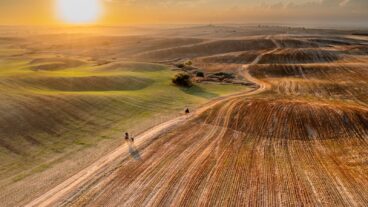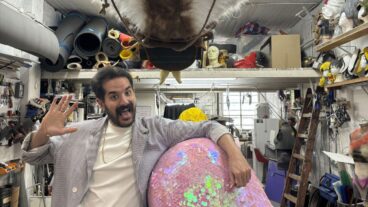Eco-architect, Elias Messinas: “One cannot have a real ecological community without the community being committed to it.”There’s a phenomenon that’s hit the world, and Israel is no exception: designers, restaurants, grocery stores, companies and architects “in the green know” are talking about sustainability. Gone are the days when a soup company can paint a “recyclable” logo on a tin can and call itself environmentally friendly.
Like in America, Israelis too have evolved the important concept of sustainability, where green practices are woven through the entire fabric of a product, building or community. Sustainability has no hard and fast rules, but works on logic, and aims to create a balance and harmony between what us humans create, and the environment we live in.
In the area of green architecture, there are about 20 architects scattered throughout Israel who envision sustainable building, where for example, buildings could create more energy than they consume. Some architects like Joseph Cory of Geotectura in Haifa develop futuristic and conceptual projects, and others like Gil Peled in Jerusalem, work to “green” old buildings from the inside out.
One of the most experienced in the green architecture field in Israel is the 44-year-old Greek-Israeli architect and consultant Elias Messinas, a veteran to the field who divides his time between Israel and Greece. His philosophies and practices are impacting green construction everywhere. He believes that educating a community about eco-issues is just as important as creating a green habitat to live inside.
Specialized in ecological building and passive solar architecture, Messinas works in Greece, Israel and Cyprus. In Greece he is working on a 2,500-unit neighborhood that could become Europe’s greenest community.
His work is published widely, including radio and TV appearances on the BBC.
Green on the periphery, like alternative medicine
Messinas owes his early green start to Israel and the Bezalel Academy of Arts and Design in Jerusalem. Back in the early 1980s, its teachers were already opening students’ eyes to green building practices; a concept not widely discussed anywhere at that time.
“They invented a curriculum,” says Messinas. “Actually the truth is that Bezalel was quite progressive . . . it had innovative brains working on green architecture at the time,” he tells ISRAEL21c.
“I felt very privileged at the time. It was a little bit [like learning] Chinese to cope with both a new profession where everything is new, and then they are telling you to turn your building to the sun and where to put the bathrooms. We were exposed to this,” says Messinas.
Working with environmental constraints at the time, he says, was very esoteric, like a doctor who practices alternative medicine. Of course in the last 10 years green architecture and design has come to the mainstream, with standards bodies emerging to certify such buildings. But back then in Israel, Messinas felt he had a special window in his studies, giving him an advanced push in a career that would take him to Yale for an architecture degree, and now a M.Sc. in Environment and Development at the National Technical University of Athens.
But it wasn’t just Israel that influenced his career: Egypt too, specifically a meeting with Hassan Fat’hi, a famous Egyptian architect who was working with Adobe bricks.
“I was so excited about Hassan’s work, I went to meet him in Cairo. This was a year before he died. It was amazing… I wanted him to tell me the big secret about architecture. He tells me Egypt will work out its problems the minute people will start to have fewer kids. I thought, that’s a dumb thing to say. It took me about 10 years to understand what he was talking about,” says Messinas.
Now stationed in Israel, with his wife and three daughters, Messinas says he is “building an environment and community consciousness. I realise that despite what we learned [about green building], one cannot have a real ecological community without the community being committed to it.”
Building the green promise
With about 10 green building projects completed and in design stage in Greece, Messinas now looks to Israel to create a green building revolution. Unlike the massive skyscrapers being built in Dubai and other Middle East cities, Messinas sees green building more modestly. And although he works with it, he is critical of the green building LEED standards, which in many cases deplete massive amounts of resources per square meter, only so the structure can be labelled “green.”
Active in environmental organizations, he is president of the NGO HELIOS for Sustainable Development, is president of the NGO ECOWEEK, which is active in Greece, Cyprus and Israel, and is a founding member and board member of the Association for Holistic Architecture and Ecological Building in Greece.
With regular trips to Greece, Messinas always has an eye on Israel and is an environmental consultant to the Kramim Eco Village project in Israel, which begins construction this summer. The materials used in the construction will be local, with an emphasis on low-energy and low-emission materials found in the area, such as adobe bricks and straw bale.
In Israel, Messinas is also organizing a Green Civil Engineering lecture series for the city of Beersheba.
“This time around [in Israel] I’m focusing on green architecture and consulting, not building,” he says, commenting on a hotel, school and building supplies center he is working on.
Flooded with ideas, in March Messinas organized a large international youth conference in Athens, bringing out students from the University of Michigan, New York, Spain, Greece, and Israel to meet with major speakers for one-on-one time, and to take the students on tours of recycling, biogas and wind farm facilities.
“In a way, I am trying to tackle things from different angles,” he concludes, with a few dozen other ideas bubbling in his mind.












